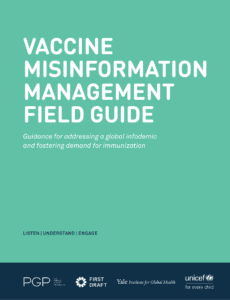Misinformation Alerts
Knowing what misinformation is being shared can help you generate effective messaging.
These insights are based on a combination of automated media monitoring and manual review by public health data analysts. Media data are publicly available data from many sources, such as social media, broadcast television, newspapers and magazines, news websites, online video, blogs, and more. Analysts from the Public Good Projects triangulate this data along with other data from fact checking organizations and investigative sources to provide an accurate, but not exhaustive, list of currently circulating misinformation.
Misinformation Alerts
Knowing what misinformation is being shared can help you generate effective messaging.
These insights are based on a combination of automated media monitoring and manual review by public health data analysts. Media data are publicly available data from many sources, such as social media, broadcast television, newspapers and magazines, news websites, online video, blogs, and more. Analysts from the Public Good Projects triangulate this data along with other data from fact checking organizations and investigative sources to provide an accurate, but not exhaustive, list of currently circulating misinformation.Alerts are categorized as high, medium, and low risk.
- High risk alerts: Narratives with widespread circulation across communities, high engagement, exponential velocity, and a high potential to impact health decisions. Are often more memorable than accurate information.
- Medium risk alerts: Narratives that are circulating in priority populations and pose some threat to health. Potential for further spread due to the tactics used or because of predicted velocity. Often highlights the questions and concerns of people.
- Low risk alerts: Narratives that are limited in reach, don’t impact your community, or lack the qualities necessary for future spread. May indicate information gaps, confusion, or concerns.
The FDA recently ended emergency use authorization (EUA) for the original Pfizer and Moderna COVID-19 vaccines, amending the authorization to include only the newer bivalent vaccines. Some vaccine opponents, including several high-profile figures, have falsely claimed that the change was due to safety concerns.
Recommendation: The high-profile nature of this misinformation and its potential to increase vaccine hesitancy elevates its risk. Prebunking messaging may explain that bivalent vaccines provide immunity against the original COVID-19 strain and later variants, while the older monovalent vaccines protect against the original strain but don’t provide strong protection against newer COVID-19 variants. Emphasizing that the FDA ended EUA for the monovalent vaccines so that people will receive the most effective vaccine to protect against currently circulating variants is recommended, as is explaining that the change has nothing to do with the safety of the original vaccines. Fact-Checking Source(s): 
An anti-vaccine social media account claims that vaccines never save lives, using measles as an alleged example. The post includes a graph that cites an anti-vaccine book to claim that measles deaths have actually increased since the introduction of the measles vaccine. The graph misrepresents several important data points, including the date of the first measles vaccine.
Recommendation: Misinformation about routine vaccines continues circulating online, fueling hesitancy and resistance to vaccines. Messaging may emphasize that measles killed millions of children annually before the introduction of the vaccine in 1963. The five years following the vaccine’s introduction saw a nearly 95 percent decline in the measles death rate in the U.S. The measle vaccine has dramatically reduced measles infections and deaths worldwide, saving millions of lives. However, measles outbreaks still occur in regions with low vaccination rates, such as the recent outbreak in Ohio that affected dozens of unvaccinated children. Fact Checking Source(s): Infectious Diseases Society of America, GAVI, College of Physicians of Philadelphia 
Vaccine opponents continue to promote misinformation about the use of mRNA vaccines in livestock. Trending posts in English and Spanish falsely claim that farmers will be required to use mRNA vaccines in their livestock and that mRNA vaccines are “gene altering.” One post claims that the U.S. pork industry has concealed its use of mRNA vaccines since 2018, while another features a supposed farmer claiming that animals don’t need vaccines.
Recommendation: The widespread nature of this claim increases its risk. Debunking messaging may emphasize that livestock vaccination to prevent disease outbreaks is not new. In fact, it’s one of the oldest forms of vaccination, dating back to the 1700s. Explaining that the U.S. doesn’t require meat producers to use any vaccine for their livestock, and no mRNA vaccines are approved for use in cattle is recommended. Some pork producers choose to use mRNA vaccines that have been rigorously tested for safety. Like all livestock vaccines, mRNA vaccines are not transmitted through meat products. Messaging may also explain that the mRNA in vaccines can’t survive inside the body for extended periods and breaks down long before the animals enter the food supply. Information about the development and use of these vaccines has been publicly available for years. Fact Checking Source(s): Farm Journal, Smithsonian Institute, NCBA, USA Today 
An image carousel posted on social media promotes the myth that millions of Americans received polio vaccines contaminated with a cancer-causing SV40 virus.
Recommendation: The persistence of this misinformation increases its risk. Some early batches of the polio vaccine were contaminated with SV40. The virus can cause cancer in rodents, but there is no evidence that it causes cancer in humans. No polio vaccine administered since 1963 has contained SV40 contamination. Messaging may continue to emphasize key talking points: The polio vaccine is safe and the only way to eradicate polio. Fact Checking Source(s): Health Feedback, FactCheck.org
Images of health insurer incentive programs for providers to encourage their patients to get COVID-19 vaccines are circulating again. A sitting U.S. congressman who has promoted vaccine misinformation in the past shared the image with the claim that insurance companies are bribing doctors to vaccinate patients.
Recommendation: The high-profile nature of this misinformation and its potential to increase vaccine hesitancy elevates its risk. Debunking messaging may explain that insurance incentive programs require doctors to meet a variety of performance goals related to the quality of patient care and health outcomes. The performance metrics include timely vaccinations, regular appointments, appropriate use of medications, disease diagnosis, and treatment. Insurance companies have a financial interest in covered patients being as healthy as possible. Messaging may also emphasize that vaccinations are integral to health care that reduce the risk of patients contracting serious and potentially fatal illnesses. Fact-Checking Source(s): 
A widely shared post is recirculating the long-disproven claim that mRNA vaccines alter human genomes. The post also repeats the false claim that mRNA vaccines will soon be added to the food supply.
Recommendation: These false claims about mRNA vaccines are persistent and widespread, which raises their risk. Debunking messaging may explain that the mRNA in vaccines can not enter the cell nucleus and does not interact with or alter genetic material in any way. The safety of COVID-19 vaccines has been rigorously studied in millions of people worldwide for over three years with no evidence of widespread health issues. Emphasizing that there are no plans to put vaccines in food or use vaccinated or genetically engineered livestock to deliver vaccines is recommended. Prebunking messaging may also explain that vaccines have been used for decades to prevent the spread of devastating infectious diseases in livestock. These vaccines are not transmitted through meat or dairy products. Fact Checking Source(s): AP News, Reuters, AFP
A far-right news site claims that the CDC Foundation funds organizations to target doctors who promote vaccine misinformation to be mass reported and stripped of their medical license.
Recommendation: The organizations in question use fact-based analysis to debunk vaccine misinformation, which may result in misinformation content being flagged or removed by social media platforms. Messaging may emphasize that doctors who circulate misinformation are not exempt from fact checking. It’s up to their licensing boards to determine if their conduct warrants a suspension of their medical license. Fact Checking Source(s): Becker Hospital Review, AMA, PolitiFact
An anti-vaccine social media account claims that medical professionals falsely classify deaths caused by routine vaccines as sudden infant death syndrome (SIDS). The account shared the story of a child who allegedly died within hours of receiving several vaccinations.
Recommendation: The persistence of this misinformation increases its risk. Debunking messaging may explain that there is no link between vaccines and SIDS. The condition’s exact cause is unknown, but numerous studies have shown that SIDS occurs at the same rate in vaccinated and unvaccinated children and has not increased with higher vaccination rates. Anti-vaccine groups have attempted for decades to falsely link various childhood vaccines to sudden infant death syndrome, despite evidence conclusively showing no link between the condition and any vaccine. Fact Checking Source(s): Children’s Hospital of Philadelphia, CDC 
A U.K.-based oncologist with a large following claims in a recent article that COVID-19 boosters cause more harm than good. He also falsely claims that the COVID-19 vaccines caused widespread injuries based on reports to Yellow Card, an adverse event reporting system similar to VAERS in the U.S. Finally, he repeats the myth that COVID-19 vaccines impair the immune system and increase cancer risk.
Recommendation: The high-profile nature of the misinformation source increases its risk. Debunking messaging may explain that there is no evidence that COVID-19 vaccines or boosters cause widespread health issues. Unverified reports of vaccine injuries do not disprove what two and a half years of large-scale studies have demonstrated: There is no link between COVID-19 vaccines and increased risk of cancer or other serious health conditions. Vaccines and boosters don’t weaken the immune system; they strengthen its ability to fight COVID-19. Fact Checking Source(s): NIH, Reuters, Health Feedback, AP
A social media post dredged up a two-decade-old conspiracy theory that the CDC covered up data showing a link between thimerosal in certain vaccines and developmental delays and autism in children. The claim is based on an image of an abstract from a “study” that found a correlation between higher doses of thimerosal and an increased rate of attention deficit disorder, tics, and speech delays in children.
Recommendation: The persistence of the misinformation increases its risk. Debunking messaging may explain that the study in question is not actually a study but an abstract of preliminary, non-peer reviewed data presented at a conference in 2000. Far from being concealed, the full transcript of the presentation is available online. During the presentation, the lead researcher explained that there were irregularities in data collection, including inconsistencies in age at vaccination and the types and combination of vaccines the children received. Emphasizing that, even at this early stage, the data showed no link between thimerosal exposure and autism is recommended. Three years after the conference, the full study was published in a peer-reviewed journal and found no link between thimerosal-containing vaccines and any developmental disorders. Prebunking messaging may also emphasize that no childhood vaccine in use since 2001 contains thimerosal. Fact-Checking Source(s): 
Alerts are categorized as high, medium, and low risk.
- High risk alerts: Narratives with widespread circulation across communities, high engagement, exponential velocity, and a high potential to impact health decisions. Are often more memorable than accurate information.
- Medium risk alerts: Narratives that are circulating in priority populations and pose some threat to health. Potential for further spread due to the tactics used or because of predicted velocity. Often highlights the questions and concerns of people.
- Low risk alerts: Narratives that are limited in reach, don’t impact your community, or lack the qualities necessary for future spread. May indicate information gaps, confusion, or concerns.
Vaccine Misinformation Guide
Get practical tips for addressing misinformation in this new guide. Click image to download, or see highlights.

